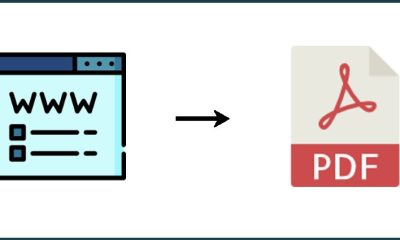Career Tips
Steps On How To Start A Business In 2024

Setting up a business is one of the most exciting and rewarding things you can do, but there is a lot to consider before you begin.
In our thorough guide to starting a business in 2024, we’ll coach you through ten critical phases, from creating your first idea to registering, launching, and expanding your business.
1. Before you begin: Get into the right mindset
While sudden successes generate headlines, they rarely reflect the realities of launching a firm. What you don’t see are the years spent dreaming, building, and positioning that business, as well as the inevitable setbacks that come with it. As a result, it’s critical to keep focused on your business and avoid comparing your performance to others.
- Consistency is key
New business owners can be motivated at first, but get disappointed as that enthusiasm fades. This is why it’s critical to develop habits and routines that will keep you going during those unavoidable energy dips.
- Take the next step
Some business founders get in headfirst and make it up as they go. Others, on the other hand, may become mired in ‘analytical paralysis’ and never get started. A mix of the two is probably a good compromise.
The greatest method to attain any company or personal objective is to write out every conceivable step required to achieve it. Then, prioritize those steps based on what has to happen first. Some processes may just take a few minutes, while others may take much longer. But the key is to always take the next step.
2. Be clear about your business idea
Some business advice instructs you to make money doing something you enjoy, but this ignores two other critical factors: it must be profitable and something you excel at.
For example, you may enjoy making cakes and wish to create a bakery in your local village, but there are already two bakeries. Perhaps you are interested in starting a bed and breakfast business but have no prior expertise in the hospitality industry.
If you don’t have a clear notion of what your business will include, consider the following questions:
- What do you love to do?
- What do you hate to do?
- Can you think of something that would make those things easier?
- What are you good at?
- What do others come to you for advice about?
- Is there something you’ve always wanted to do, but lacked resources for?
These types of queries can spark an idea for your business. They may be able to help you expand on an existing idea. Once you’ve decided on an idea, assess its feasibility and profitability.
What kind of business should you start?
If you’re not sure what kind of business you want to establish, examine these crucial considerations to help you decide:
- What type of funding do you have?
- How much time do you have to invest in your business?
- Do you prefer to work from home or at an office or workshop?
- What are your interests and passions?
- Can you sell information (such as a course), rather than a product?
- What skills or expertise do you have?
- How fast do you need to scale your business?
- What kind of support do you have to start your business?
- Are you partnering with someone else?
- Does the franchise model make more sense to you?
Consider popular business ideas
You might also consider launching a franchise. This is where you run a business but are licensed to trade under another company’s branding and business strategy. Many fast food businesses and takeaway services are set up in this manner, for example. Alternatively, you could consider launching an internet business, such as a blog or an online store.
3. Research the competition
Many entrepreneurs devote more time to developing their product or service than to learning about their competitors.
If you ever request for capital for your business, the bank, potential lender, or partner will want to know what distinguishes you (or your business idea) from the competition.
If a market analysis shows that your product or service is saturated in your area, consider a new approach. For example, if you own a cleaning business, instead of offering general cleaning services, you may focus on cleaning homes with dogs or garages.
- Primary research
Primary research is collecting data directly from potential customers rather than drawing conclusions based on previous data. Questionnaires, surveys, and interviews can be used to learn about consumer preferences.
Surveying friends and family is not recommended unless they are your target audience. People who claim they would buy something differ greatly from those who really do.
- Secondary research
This is the use of existing sources of information, such as census data and other publicly available statistics, to learn about your target market.
- Complete a SWOT analysis
SWOT refers to strengths, weaknesses, opportunities, and threats. It’s a clever approach to see how your product or idea might do if it were put to market, and it can help you make decisions regarding the path of your concept.
Your business proposal may have some flaws that you hadn’t considered, or there may be opportunities to improve a competitor’s offering.
The tables below give examples of the sorts of questions you might ask in your SWOT analysis:
4. Create your business plan
A business plan is a dynamic document that acts as a road map for starting a new firm. It should be clear for potential investors to comprehend what your company does and where it’s going.
Even if you plan to self-fund, a business plan can help you flesh out your concept and identify potential issues. When drafting a comprehensive business strategy, incorporate the following sections:
- Executive summary: The executive summary should appear first in the business plan, although it should be written last. It defines the proposed new business and highlights the company’s aims and techniques for achieving them.
- Company description: explains what problems your product or service solves and why your business or idea is the best. Perhaps your background is in molecular engineering, and you’ve used that knowledge to develop a new form of sporting clothing. You have the right credentials to create the finest content.
- Market analysis: This portion of the business plan examines how well a company compares to its competitors. The market analysis should contain the target market, segmentation, market size, growth rate, and trends.
- Organization and structure: Write about the type of business organization you expect, what risk management strategies you propose and who will staff the management team. What are their qualifications? Will you be a sole trader, a partnership or will it be a limited company, for example?
- Mission and goals: This section should contain a brief mission statement and detail what the business wishes to accomplish and the steps to get there. These goals should be SMART – that is: specific, measurable, action-orientated, realistic and time-bound
- Products or services: This part explains how your business will run. It comprises what items you’ll provide to consumers at the beginning of the firm, how they compare to existing competitors, how much your products cost, who will be responsible for generating the products, how you’ll acquire materials, and how much they cost to manufacture.
- Background summary: This portion of the business plan is the most time consuming to write. Compile and summarize any data, articles and research studies on trends that could positively and negatively affect your business or industry
- Marketing plan: The marketing plan identifies the characteristics of your product or service and summarizes the SWOT analysis and analyses competitors. It also discusses how you’ll promote your business, how much money will be spent on marketing and how long the campaign is expected to last.
- Financial plan: The financial plan is perhaps the core of the business plan because – without money – the business cannot move forward. Include a proposed budget in your financial plan along with projected financial statements, such as an income statement, a balance sheet and a statement of cash flows. Usually, five years of projected financial statements are acceptable. This section is also where you should include your funding request if you’re looking for outside funding.
Establish an exit strategy
An exit strategy is essential for any firm seeking finance because it specifies how you will sell the company or transfer ownership if you decide to retire or pursue other opportunities.
An exit strategy also assists you to maximize the value of your business when it comes time to sell. There are several possibilities for departing a firm, and the ideal one for you depends on your objectives and circumstances.The most commonly used escape strategies are:
- Selling the business to another party
- Passing the business down to family members
- Liquidating the business assets
- Closing the doors and walking away
Develop a scalable business model
As your small business grows, it’s critical to have a scalable business plan that allows you to accept increasing numbers of consumers without incurring additional costs.
A scalable company strategy is one that can be easily copied to serve more clients while incurring minimal additional expenses. Some common scalable business models are:
- Subscription-based businesses
- Businesses that sell digital products
- Franchise businesses
Think about tax planning
When starting your business, think about how you want to structure it. The structure or setup you choose will affect how your business is taxed – and how much tax you pay – as well as whether your personal assets are at risk if the firm fails.
There are three sorts of small business setups: solo trader, partnership, and limited company. The setup you choose will depend on the type of business you have and how you intend to run it.
- Sole trader
This is the most basic setup for your firm. You will have to register as a sole trader with HMRC (the tax authority). It’s crucial to understand that as a sole trader, you are individually liable for any business debts.
As a sole trader, you are compelled by law to pay tax via the self-assessment system. This implies that you must file a tax return each year to inform HMRC of your earnings. To achieve this, you must first sign up for self-assessment.
- Partnership
A partnership is the most straightforward approach for two or more people to operate a business together. You will share responsibility for your company’s debts, profits, and losses.
There will be accounting duties, and you must register with HMRC. Every year, each partner in a partnership must file a personal self-assessment tax return to pay tax on their portion of the business’s profits. A nominated partner must additionally file a partnership tax return with HMRC.
- Limited company
If you opt to form a limited company, your business’s finances and taxation will be kept separate from your personal finances.
However, with this option, there will be additional accounting and management obligations and requirements. Many business owners who take this route hire an accountant or tax expert to assist with these arrangements, but you can do it yourself. Limited companies must register with Companies House and the HMRC.
Once your company has a turnover of at least £85,000, you must register to pay VAT. This applies to solo traders, partnerships, and limited companies. The government’s website, Gov.uk, provides information regarding business models and tax implications.
5. Register your business
There are usually legal issues to address when starting a business. The following is a good checklist of items to consider when establishing your business:
- Choose your business name
- Register with Companies House (for limited companies)
- Register your business with HMRC
- Apply for the required permits or license necessary for your business.
You may require a license or permit to be a street trader, sell food or beverages, or play music, for example. Contact your local government or council to learn about the legal requirements for your business.
6. Get your finances in order
This is a big and ongoing job which can be broken down into several steps.
- Open a business bank account
It’s critical to keep your business and personal cash separate, so look into the best business bank accounts for your needs. This account can be used for business operations such as supplier payments and customer invoices. You may also want to consider getting a company credit card to help with monthly cash flow.
- Accounting software
Consider whether you’ll need to hire an accountant or whether you can utilize appropriate software. You can use a variety of software packages, and the majority will keep track of your expenses and income, issue invoices, run reports, and calculate tax responsibilities.
- Insurance
Even if you run your business from home and have no workers, you will almost always need insurance. Speak with an independent insurance broker to determine what insurances may apply to your business and what levels of coverage are acceptable for your needs.
Here are the business insurances to consider:
- Liability insurance: which protects your business against third-party claims of bodily injury, property damage and personal injury such as defamation or false advertising
- Property insurance: which covers the physical assets of your business, including your office space, equipment and inventory
- Business interruption insurance: which pays for the loss of income if your business is forced to close temporarily due to a covered event such as a natural disaster
- Product liability insurance: which protects against claims that your products caused bodily injury or property damage.
- Employer liability insurance: which covers you against claims from employees alleging discrimination or wrongful termination. This policy will also often cover medical expenses and income replacement for employees who are injured on the job.
7. Funding your business
There are numerous ways to fund your business; some involve significant work, while others are more easily obtained. Funding is divided into two categories: internal and external.
Internal funding includes:
- Personal savings
- The right credit cards
- Funds from friends and family
If you finance the firm with your own money or credit cards, you must pay off the debts, and if the business fails, you will lose a portion of your assets.
However, by allowing family members or friends to invest in your firm, you risk harming those ties if the company fails and you are unable to repay them.
Business owners that want to reduce such risks may explore seeking external finance. Consider applying for a small business loan or a business grant.
External funding includes:
- Small business loans
- Small business grants
- Start-up investors
- Venture capital
- Crowdfunding.
Small firms may need to tap into multiple sources of finance. Consider the amount of money required, how long it will take for the company to repay it, and how risk-tolerant you are.
Funding ideas might include the following:
- Invoice factoring: With invoice factoring you can sell your unpaid invoices to a third party at a discount. The invoice factoring market is not regulated
- Business credit cards: You can apply for a business credit card to access credit and manage cash flow. Credit limits and interest rates will be based on your business’s revenue, credit score and financial history
- Equipment financing: If you need to purchase expensive equipment for your business, you could finance it with a loan or lease
- Small business loans: Offered by a range of lenders, these can be used for working capital, inventory or supplies and machinery or equipment. Being accepted for a loan will depend on your business revenue and credit score. Small start-up loans are also available from the Government, so find out if your business venture is eligible
- Grants: A small business grant is different to a loan in that you won’t have to pay it back. But they can be difficult to find and obtain. Some government grants are available, although many offer money for specific things, such as grants to take on an apprentice or to help rural businesses upgrade their broadband. Charity The Prince’s Trust has some grant funding for businesses set up by young people. The National Lottery Heritage Fund also offers grants
- Crowdfunding: With this type of innovative finance you can raise money from a large group of people, usually by way of an online platform, by soliciting donations or selling equity in your company.
Choose the best funding source for your business based on the quantity of money you require, the repayment time frame, and your risk tolerance.
8. Get the right tools
firm tools can help you simplify your life and manage your firm more efficiently. The appropriate tools can help you save time, automate activities, and make more informed decisions.
Consider the following tools in your arsenal:
- Accounting software: Track your business income and expenses, prepare financial statements and pay taxes
Customer relationship management software (CRM): This can help you manage your customer relationships, track sales and marketing data, for example, and automate tasks like customer service and follow-ups - Project management software: Plan, execute and track projects. It can also be used to manage employee tasks and allocate resources
- Card payment technology: This will allow you to accept credit card payments from customers
- Point of sale technology: A system that allows you to process customer payments. Some accounting software and CRM software will have POS features built-in
- Getting a VPN: A VPN or Virtual Private Network – provides a secure, private connection between your computer and the internet. Choosing the best VPN is important as it handles sensitive data, such as customer details and financial information
- Merchant services: When customers make a purchase, the money is deposited into your business account. You can also use merchant services to set up recurring billing or subscription payments
Email hosting: This allows you to create a professional email address with your own domain name.
9. Marketing Your Business
Many business owners spend so much money developing their goods that the marketing budget is depleted by the time the product is ready for launch. Alternatively, they’ve spent so much effort on product development that marketing is an afterthought.
Here are some factors to consider while promoting your new business.
- Create a website
Even if you have a physical storefront, having a website is usually required. Creating a website does not take long; you may complete one in as little as a weekend.
You can create either a regular information website or an e-commerce site, which allows you to sell things online. If you provide products or services offline, make sure your website has a clear page where buyers can identify your locations and trading hours.
- Optimize for SEO
After creating a website or e-commerce business, concentrate on optimizing it for search engines (SEO). This simply implies that when potential buyers search Google for specific keywords for your products, the search engine or Google will direct them to your website. SEO is a long-term plan, so don’t expect to receive a lot of traffic from search engines straight away—even if you use all of the proper keywords.
- Get listed in internet directories
Customers utilize online directories to locate the products and services they require. Include your company in as many appropriate directories as possible. You can also list your company in industry-specific directories.
- Create a social media strategy
Your potential clients use social media on a daily basis; you should too. Share material that is intriguing and relevant to your audience. Use social media to direct visitors back to your website, where they can learn more about your business and purchase your products or services. You don’t have to use every social media platform available.
However, you should have a presence on Facebook and Instagram because they both provide e-commerce tools that allow you to sell directly from your social media accounts. Both of these platforms offer free ad training to assist you market your business.
10. Scale up your business
To scale your firm, you must increase your customer base and revenue. This can be accomplished by increasing your marketing efforts, developing your product or service, working with other producers, or introducing new items or services that complement your current offerings.
Consider how you can automate or outsource certain jobs so you can focus on growing the firm.
Accounting, email marketing, and lead creation are all examples of company activities that may be automated using technology. This will allow you to spend more time on other elements of your business.
When scaling your firm, keep an eye on your finances and keep costs low to guarantee that you remain profitable. If you aren’t producing enough money to pay your expenses, you must either cut your spending or discover alternative ways to raise your revenue.
- Build a team
As your firm expands, you’ll need to delegate responsibilities and form a team to assist you with day-to-day operations. This could include employing new employees, contractors, or freelancers.
Resources for forming a team include:
- Hiring platforms: To find the right candidates, hiring platforms can help you post job descriptions, screen résumés and conduct video interviews
- Job boards: Job boards allow you to post open positions for free
- Social media: You can also use social media platforms such as LinkedIn and Facebook to find potential employees
- Freelance platforms: These can help you find talented freelancers for one-time or short-term projects. You could also outsource certain tasks, such as customer service, social media marketing or bookkeeping.
You could also consider collaborating with other companies in your field. For example, as a wedding planner, you could collaborate with a florist, photographer, food company, or venue. This manner, you can provide your consumers with a one-stop shop for all of their wedding necessities.
Another example is an e-commerce store that collaborates with a distribution company. This type of arrangement can help you save money on shipping and storage costs while also allowing you to get your products to clients faster.
To identify possible partners, look for businesses in your industry that compliment what you do. For example, if you are a site designer, you could collaborate with a digital marketing agency.
You can also look for firms that serve the same demographic as you but provide different products or services. For example, if you offer women’s clothing, you could collaborate with a jewelry store or a hair salon.
Bottom line
Starting a small business requires time, work, and perseverance. However, if you’re ready to put in the effort, it can be an excellent approach to realize your aspirations and goals. Do your homework, build a sound business plan, and pivot as needed along the route. Once you’re up and running, remember to keep focused and organised so you can continue to grow your business.
FAQ
- How much does it cost to start a business?
The cost of launching a business will vary depending on the size and type of firm you intend to establish. For example, starting a home-based business will be less expensive than opening a brick-and-mortar shop or restaurant.
Furthermore, the cost of beginning a business will rise if you have to rent or purchase commercial space and hire employees. If you wish to sell goods or services online, you might be able to start free.
- How do I start a small business with no money?
There are various funding options for fledgling firms, including the government and nonprofits. Consider start-up investor finance and crowdfunding opportunities, as well as more traditional commercial bank loans.
- What are the most successful small businesses?
There is no single answer to this issue, or which types of businesses will generate the most money, because the most successful and profitable form of business will differ depending on a variety of criteria, including your industry, location, target market, and business model.
Some businesses are more profitable than others, such as those who provide luxury items or high-end services, as well as business-to-business and subscription-based firms.
If you’re not sure what type of business to start, think about your abilities and hobbies, as well as the needs of your target market, to help you select a viable business idea.
- How do I set myself up as a small business?
The best business structure or set up for your business will depend entirely on what kind of company you want to create, your industry and what you want to accomplish. But any successful business structure will be one that will help your company set realistic goals and follow through on set tasks.
- Can I run a business from my home?
Yes, you may operate a business from home. Many small enterprises begin this way. However, depending on the nature of your business, you may be required to comply with a variety of rules and regulations.
You should also ensure that you have adequate insurance coverage. If customers visit your home, you will require public liability insurance.
- What are the best small businesses to start?
Selling digital goods is one of the easiest companies to start and has the lowest overhead costs. This can contain things like e-books, online courses, audio files, and software.
If you are a specialist in a specific field or niche, this is an excellent alternative. Buying and selling wholesale products, or manufacturing your own, is another simple way to generate money if you can find a suitable market for them. After you’ve created your product, you may sell it on your own website or through third-party marketplaces like Amazon or Etsy.
- How can a beginner start a business?
Starting your own profitable business does not require extensive business experience; all you need is a strong idea, as well as rigorous research and planning. Always prepare a detailed business plan to help you navigate the process.
Many business owners begin their businesses while working a ‘day job’, if possible, to get the firm off the ground before committing to it full-time.
- Do I need a business degree to start a business?
You do not need a business degree to start a business. However, obtaining a degree in business or a similar discipline can give you with the knowledge and skills necessary to manage a successful organization. Alternatively, you could consider attending a business class to learn more about starting and running a firm.
- How do I get a loan for a new business?
The best strategy to obtain a loan for a new business is to visit banks or other financial institutions and present them with a business plan and financial information. Consider government-backed loans and grants, as well as alternative funding platforms like crowdsourcing.












